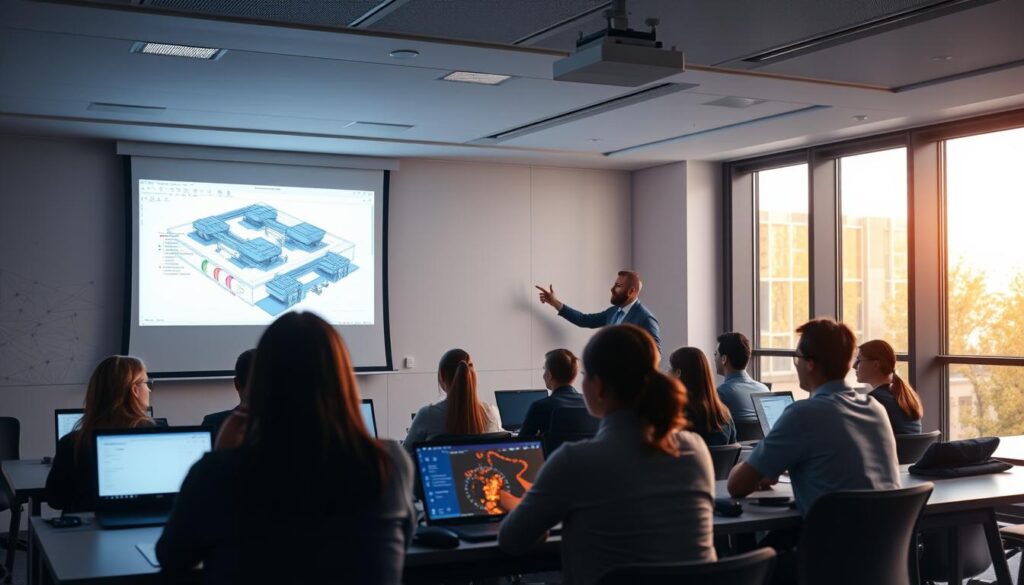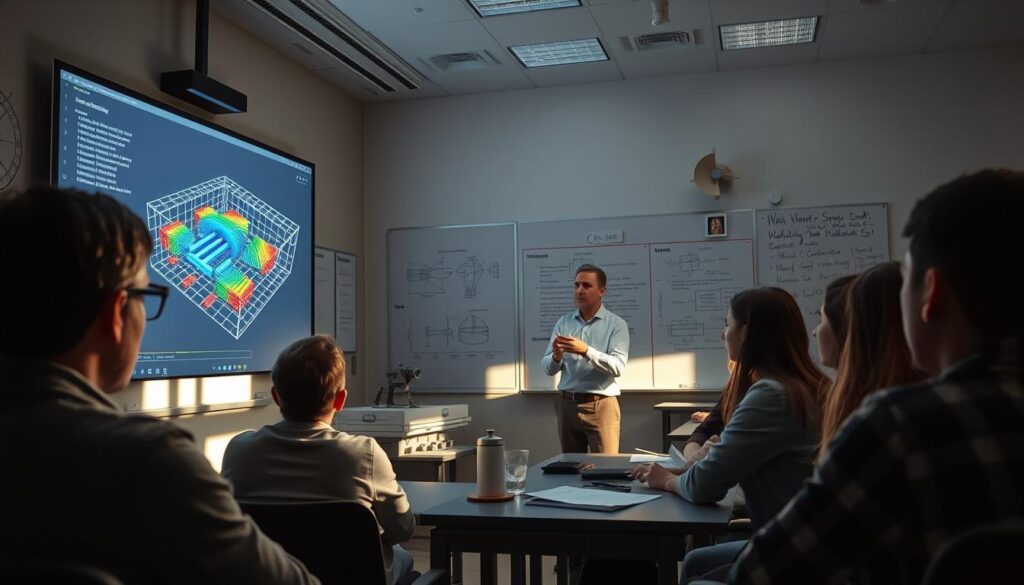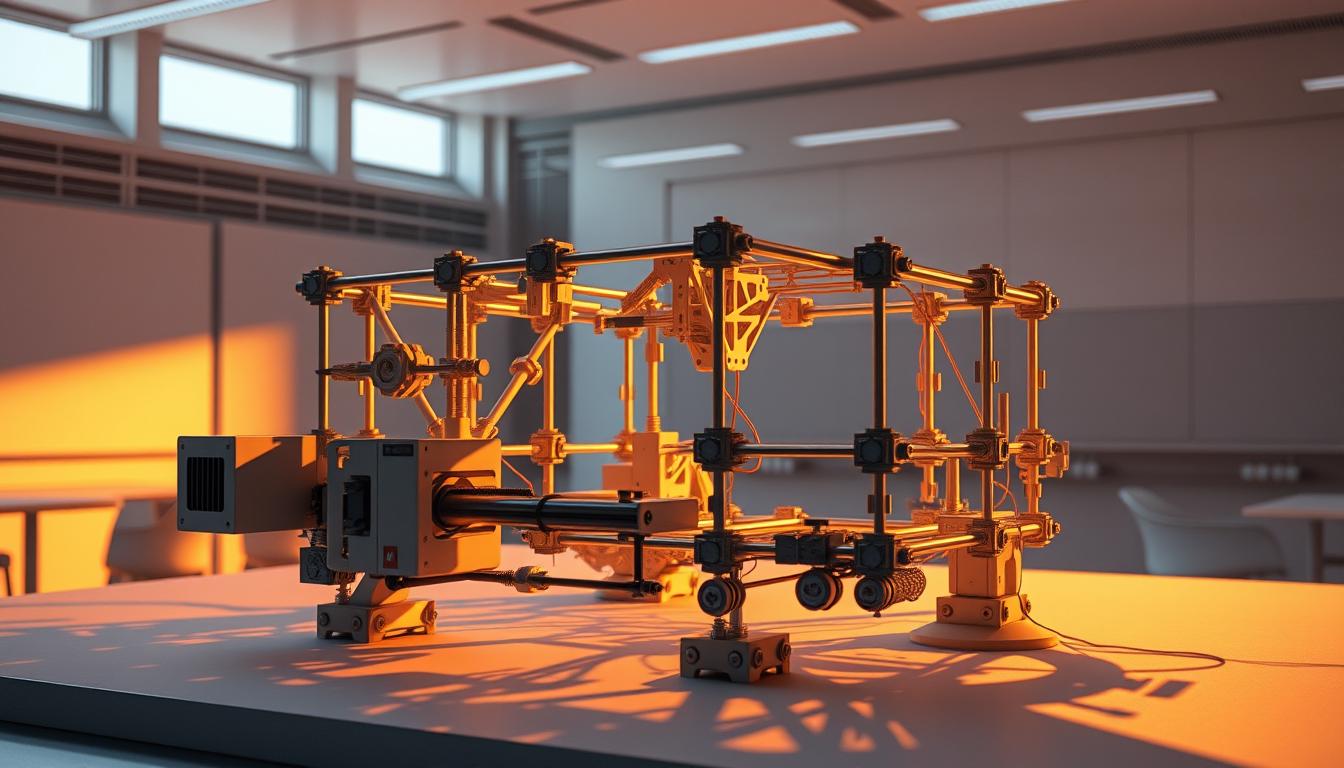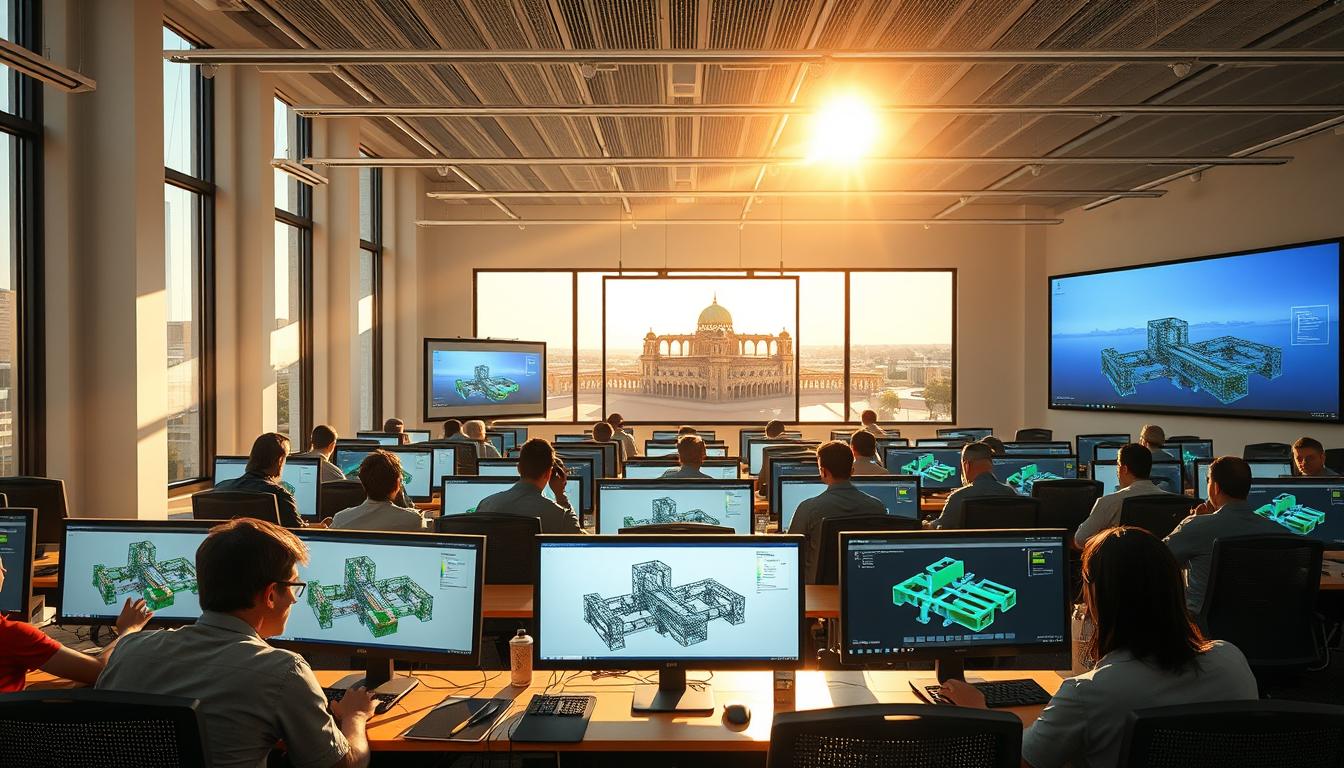Ever thought about how engineering students learn about stress analysis without real risks? Simulators are changing engineering education. They let students explore stress analysis safely, making mistakes and learning before they work in the field.
Simulation-based education is key in engineering. It connects theory with practice, shaping the future of engineering education. It boosts critical thinking and prepares students for real-world challenges, showing the wide impact of simulation technology.
Introduction to Simulation-Based Education
Simulation-based education (SBE) is a new way to learn. It uses real-life scenarios to make learning more engaging. This method helps students connect theory with practical skills, especially in engineering.
By using advanced tools, SBE makes learning immersive. It lets students apply what they learn in real-world situations.
In today’s virtual learning environments, SBE is a safe space for students to practice. It helps them think critically and make better decisions. With technologies like virtual reality, SBE is becoming even more powerful, offering deeper learning experiences.

The Importance of Stress Analysis in Engineering Education
Stress analysis is key in engineering education. It helps students understand the engineering principles that control how materials react under different conditions. Knowing stress analysis is crucial for engineers to ensure structures are safe and reliable.
Engineering education focuses a lot on material behaviors under stress. This knowledge is essential for designing parts that can handle loads without breaking. Students study mechanical properties like tension, compression, and shear strength. This gives them a better understanding of how materials perform.
Using simulations in training makes learning more practical. It lets students apply what they’ve learned from textbooks to real-world problems. This hands-on experience is vital for their future careers. Learning stress analysis prepares students for technical challenges and teaches them about design safety.

Understanding Simulation-Based Learning Environments
Simulation-based learning environments are different from regular classrooms. They offer a dynamic way to learn, making education more engaging. Students get to interact more, which helps them learn better.
Unlike just listening to lectures, these environments let students do things. They can try out what they’ve learned in real-life situations. This makes learning more active and fun.
Getting feedback is key in these environments. Students get instant feedback on their actions. This helps them improve and think critically.
Students also learn to reflect on their own learning. They can see what they did well and what they need to work on. This helps them grow and get better.
Technology makes simulation-based learning even better. It uses virtual platforms and advanced software. This creates real-life scenarios for students to practice in.
This approach helps students remember what they’ve learned. It also builds their confidence as they tackle tough subjects. They feel ready for challenges in their future careers.
Benefits of Simulators for Stress Analysis Teaching for Engineering Students
Simulators in engineering education bring big benefits for teaching stress analysis. They offer a safe space for practical training. Students can try out ideas without the dangers of real-world projects.
Students can learn at their own speed. They can go over tough material as many times as they need. This helps them feel sure about their skills, which is key in engineering.
Getting feedback right away is a big plus. Students see how their choices work out instantly. This helps them get better fast, making learning more effective.
Simulators also let students face challenges they might not see in class. These scenarios prepare them for what they’ll face in their careers. So, simulators make learning stress analysis better, giving students the skills they need for their jobs.
Types of Simulators Used in Stress Analysis Training
In engineering education, different simulators help with stress analysis training. They prepare students for real-world tasks. These tools include high-fidelity mannequins and virtual reality simulations. Each has its own benefits, helping students understand stress analysis better.
High-fidelity mannequins mimic real-life situations. They allow students to practice and check their stress response skills. These simulators give a deep look into stress analysis mechanics.
Virtual reality (VR) simulations create an immersive space for students. They can try out different stress scenarios. This makes learning fun and helps students see how stress affects structures.
Hybrid models mix real and virtual parts. They offer a balanced approach for different learning styles. Students can work with real materials and see stress impacts on screens.
Knowing about the different simulators can really help in engineering education. Each type meets different learning needs. They ensure students get the skills needed for real engineering challenges.
Simulation-Based Training: A Historical Perspective
The history of simulation-based training shows how training methods have changed over time. At first, people learned by doing, through apprenticeships. These hands-on experiences were key to mastering skills.
In the 1960s, simulators started to appear. They were designed to mimic real-world situations. This was a big step forward in learning.
These early simulators paved the way for today’s training. Now, we have advanced computer models. These models offer interactive learning experiences, perfect for complex subjects like engineering.
Today, simulation-based training uses high-fidelity models. These models are very realistic, making learning feel like real-life challenges. This shows how training has evolved, making learning in engineering better.
| Era | Training Methods | Key Developments |
|---|---|---|
| Pre-1960s | Traditional Apprenticeships | Hands-on experience, mentor-based learning |
| 1960s | Introduction of Simulators | Basic mechanical simulations, first computerized models |
| 1980s-1990s | Advent of Computer-Based Training | Interactive training modules, multimedia learning |
| 2000s-Present | High-Fidelity Simulators | Virtual environments, immersive technology |
Integration of High-Fidelity Simulators in Engineering Curricula
Engineering education is changing with new technology. High-fidelity simulators are key, making learning more engaging and effective. They offer real, hands-on experiences that help students grasp complex engineering ideas, especially in stress analysis.
Using these simulators well needs careful planning. Schools can follow a few steps:
- Make sure the simulators match the learning goals, so students can use what they learn in real situations.
- Help teachers learn how to use the simulators in their classes.
- Use the simulators in team projects, combining different subjects and teaching teamwork and practical skills.
Many engineering programs have seen great success with these simulators. Top universities have added them to mechanical and civil engineering classes. This makes learning more interactive, letting students tackle real problems in a safe space.
High-fidelity simulators are key in bringing technology into engineering classes. They improve learning and get students ready for the fast-changing job market.
Simulation Scenarios and Their Impact on Learning Outcomes
Simulation scenarios are key in improving education for engineering students. They create real-world settings where students can apply what they’ve learned. This hands-on approach boosts active learning and critical thinking.
How complex these scenarios are matters a lot. Studies show that challenging scenarios help students understand and remember more. When faced with tough problems, students think more deeply and work better together. This makes learning more effective.
The following table shows how scenario complexity affects learning outcomes:
| Scenario Complexity | Educational Impact | Learning Outcomes |
|---|---|---|
| Low Complexity | Basic understanding of concepts | Limited application of knowledge |
| Medium Complexity | Increased engagement and participation | Moderate application of knowledge |
| High Complexity | Enhanced problem-solving skills | Advanced application of knowledge |
By using these detailed scenarios, schools can greatly enhance what students learn. Students get a deep grasp of stress analysis. This prepares them well for their careers.
Simulators for Stress Analysis Teaching for Engineering Students
Engineering simulators are key in teaching stress analysis. They give students hands-on experience in a safe space. These tools help students see how stress spreads, how loads are managed, and how materials behave under different conditions.
These simulators are vital in today’s engineering classes. They connect theory with practice, making learning more effective.
One big plus of these simulators is the ability to analyze data in real-time. Students can see how their actions affect a structure’s strength right away. This interactive learning helps students think critically and solve problems better.
Engineering simulators are used in many areas of study. Students in civil, mechanical, and aerospace engineering can try out different stress analysis models. This broadens their understanding of engineering.
Learning with these tools makes students ready for real engineering challenges. It’s a step towards becoming a skilled engineer.
Using engineering simulators in teaching stress analysis makes learning better. Schools that invest in these tools prepare students well for their future careers. Students learn both theory and practical skills.
Reducing Student Anxiety Through Controlled Simulation Environments
Student anxiety can really hold back learning and performance. Controlled environments offer a safe space for students to practice and learn. This way, they can build their skills in a supportive setting that boosts confidence.
Simulated experiences let students tackle tough situations with less stress. By creating learning activities that mimic real-life scenarios, teachers prepare students better. This mix of practice and support leads to better results in school and life.
Here are some ways to create safe spaces for students:
- Use low-stakes assessments that focus on skill-building, not grades.
- Encourage teamwork to build a sense of community and support.
- Give feedback that focuses on growth and improvement.
- Use technology for repeated practice and instant feedback.
These controlled environments also boost student motivation. When students feel safe and supported, they’re more likely to take risks and dive into their learning. Simulations play a big role in helping students succeed while managing their anxiety.
Facilitator Role in Successful Simulation-Based Learning
The role of a facilitator in simulation-based learning is key. They design and deliver simulations that meet learning goals. These simulations make complex ideas easy to understand and create a lively learning space.
Facilitators guide students through these scenarios. They use teaching strategies to get students involved and thinking critically. They also give feedback in real-time, helping students learn from their actions.
Facilitators also lead debriefing sessions after simulations. These sessions help students make sense of their experiences. They share their insights and see how theory applies to real life. The facilitator’s skill in leading these discussions greatly affects student learning.
In summary, facilitators are crucial for simulation-based learning success. They use the right teaching methods and create a space for exploration and discussion. This greatly improves the learning experience for engineering students, especially in stress analysis.
Debriefing Techniques to Enhance Learning in Simulation
Effective debriefing techniques are key to learning from simulations. These sessions let students reflect on their actions, aiming to strengthen their skills. By analyzing specific scenarios, students get insights that go beyond just book knowledge.
In debriefing, prompts spark meaningful talks among students. This teamwork helps them think deeply about their actions and choices. Trainers guide these discussions, focusing on what worked well and what didn’t, helping everyone grow.
Using methods like oriented questioning and role-reversal exercises boosts critical thinking. Students share their thought processes and explore different ways to solve problems. This practice not only reinforces what they’ve learned but also sharpens their problem-solving skills.
Using different debriefing methods in training improves learning. A good debriefing session helps students understand more deeply. It prepares them for future challenges, both in school and in their careers.
Challenges Faced in Implementing Simulation in Education
Switching to simulation-based education comes with many hurdles. It’s important for educators to understand these challenges. Financial issues and the need for the right setup are major obstacles.
Teachers also struggle to change their teaching ways. They might not know how to use new tools well. Training programs can help them learn new teaching methods.
Another problem is that not all students have the same access to technology. This can lead to unfair learning chances. Schools need to make sure everyone can use simulation tools.
| Challenge | Description | Proposed Solution |
|---|---|---|
| Cost | High financial investment for simulators and maintenance. | Seek partnerships with tech companies for funding and resources. |
| Instructor Training | Lack of training for instructors on simulation tools. | Implement ongoing professional development programs. |
| Technology Access | Inconsistent access to necessary technological resources among students. | Provide centralized resources and support to ensure equitable access. |
| Adaptation to Teaching Methods | Difficulty in integrating simulation into existing curricula. | Encourage collaboration among faculty to share best practices. |
Emerging Technologies in Stress Analysis Simulation
The world of engineering education is changing fast. New technologies are making it easier for students to learn about stress analysis. Tools like artificial intelligence, virtual reality, and data analytics are changing how we learn.
Artificial intelligence helps make learning more personal. It lets students learn at their own pace in stress analysis. This way, they can improve where they need to, making learning more effective.
Virtual reality brings complex scenarios to life. Students can explore three-dimensional models and see how forces and materials work. This hands-on learning helps them understand better and feel less stressed.
Data analytics helps teachers see how students are doing. They can track who’s engaged and what they’re struggling with. This helps teachers adjust their teaching to meet the needs of their students, keeping education fresh and relevant.
Ongoing Research and Advancements in Simulation-Based Education
The field of simulation education is always growing, with new discoveries. Studies are looking at how different simulators affect learning in engineering. They want to know how new teaching methods can make simulation learning better.
Recent studies show that high-fidelity simulators are great for linking theory to practice. They make students more engaged and help them understand better. This reduces the difference between what they learn in class and what they see in real life.
Looking ahead, research will focus more on virtual reality and artificial intelligence. These technologies will make learning more immersive and personalized. As schools start using these tools, research will help us see how they change engineering education for the better.
Conclusion
Simulators play a huge role in engineering education, especially in stress analysis. They make learning easier and safer. Students can practice without real-world risks.
These tools do more than just teach. They help students think critically and solve problems. These skills are key in engineering.
We looked at the good and bad sides of using simulators in class. As tech gets better, learning will too. We see a future where simulators are a big part of education.
Good teaching and skilled instructors are key to using simulators well. They help students understand stress analysis better. This prepares them for their future careers.




